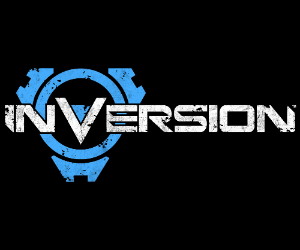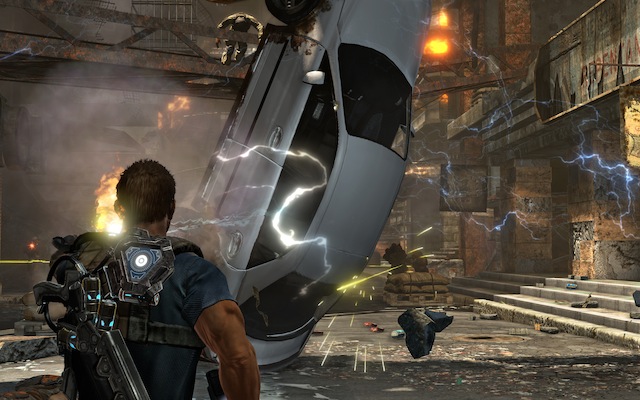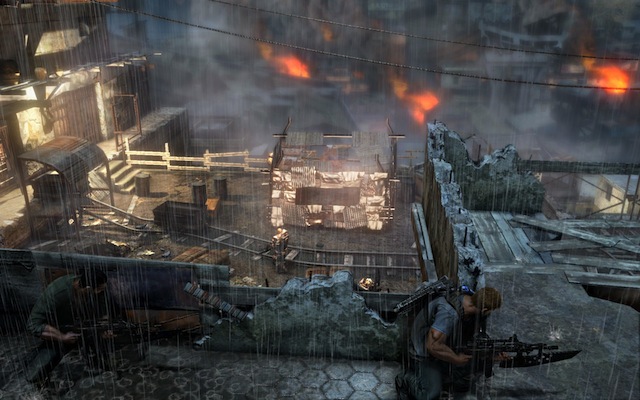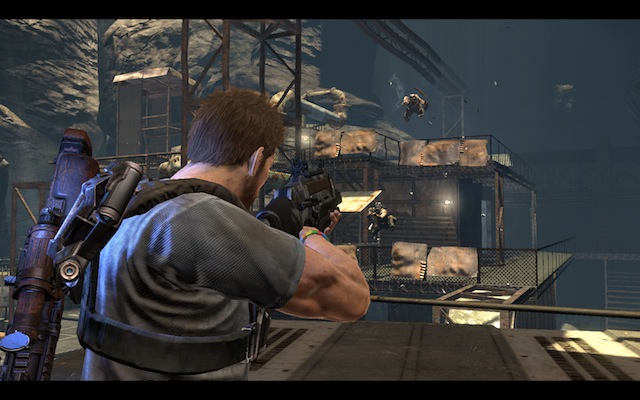Inversion Review
 Game: Inversion
Game: Inversion
Developer: Saber Interactive
Publisher: Namco Bandai Games
Available on: Xbox 360, PlayStation 3, Windows PC (Reviewed on Xbox 360)
When I first saw Inversion advertised, and when I first booted up the game, I was reminded of the failed LucasArts game Fracture. It could have been the single word title for the game, it could have been the world-changing main gameplay mechanic or something a little but more subtle. Either way I wasn’t excited for the game when I first started playing but things did start to change, the first ten minutes wasn’t bad, the next ten minutes got a little bit better then, when the gravity changing mechanic started kicking in, things got even better. Was the game able to maintain that climb and become something truly special, or did it stall itself by climbing too high too fast?
STORY: The story in Inversion starts as a mysterious organisation known as the Lutadore invade the fictional Vanguard City, where our unlikely heroes of Davis Russel and Leo Delgado are cops. Everything seems to go from bad to worse as Russel and Delgado realise that not only are the Lutadore invading with a hell of a lot of heavy weapons, but they also have some futuristic weapons which have the capability of effecting the gravity in localised areas, sometimes making objects float in zero-gravity, sometimes making things heavier than they usually would be, and in other cases completely changing which direction which is designated as “down”. You could easily find yourself using what used to be the ceiling as the floor and that’s something that you’re just going to have to deal with, even while thousands of bullets are flying past your ears.

The story is interesting enough to keep people playing until the end of the game but it’s nothing special, the only thing that makes it different from any other generic third person shooter is the addition of the gravity changing mechanic. This particular mechanic isn’t overused in the game, which is a saving grace as it could easily have been a gimmick that the developers used because they knew it was fun. As it stands, it leaves you wanting just a little bit more, which is a balance that feels about right.
GRAPHICS: Inversion makes use of the Unreal Engine 3 to get its visuals across, so most players will know what they’re in for from the get go. The main characters within the game, Davis Russel and Leo Delgado, are well modelled – though some of them look like they’ve been on the steroids a little bit too much – but the enemy models are where things start to break down. Apart from a couple of the bigger enemies, there are only a couple of enemy models that’ll be thrown at you for the majority of the game. Sure, you can blank this out when you’re mowing them down with streams of bullets, but you’ll soon find yourself visually exhausted and looking for something new which never really comes.
Another problem that the game suffers from is the fact that textures pop in and out all of the place throughout the entire game, a typically Unreal problem. You’ll often find yourself loading into a cutscene only to see Davis and Leo rendered as a grey/brown mess, which you’ll be forced to look at for a few seconds until the actual high resolution textures stream in from the engine. It’s not really a deal breaker but it certainly makes the game look a lot less polished than it otherwise would.

SOUND: Serviceable at best, the guns (even though you’ll only be using a couple of them throughout the game) sound the part but they’re not anything overly spectacular. As long as the guns sound like guns and the grenades explode with enough of a “boom” to make the players feel like they’re doing something then the audio department has done their job properly. The voice acting however, isn’t exactly top-notch. Some of the lines that you’ll come across through your time with the game will be some of the cheesiest line you’ve heard in video games for a while, at some points you may actually think you’re watching an 80s B-Movie. The sub-par vocal acting could be down to the story being a little bit lacklustre but a decent voice actor would be able to elevate the writing in some regard; Inversion is just adequate the whole way through.
GAMEPLAY: As you’d probably expect from a game that looks as much like a generic third person shooter as Inversion does, you’ll most be shooting the plethora of bad guys that you’ll come face to face with. You’re given a couple of weapons to do this with but you’ll pretty much go through the entire game with only a couple of them, swapping out when you run out of ammo on one and then switching straight back to it once you’ve found an ammo cache hidden away among the rubble. Despite the generic nature of the combat it never really feels tired, if you enjoy third person shooter games then you’ll probably enjoy Inversion too. While it doesn’t bring anything new to the table in terms of the shooting mechanic, it also doesn’t take anything away. As the old saying goes “if it isn’t broken, don’t fix it” and Saber Interactive certainly haven’t even attempted to “fix” anything at all.
Apart from the shooting, the other gameplay mechanic that you’ll come across during your time with Inversion is altering the gravity. After about an hour of gameplay you’re given a device (well, you take it from a storage room after you’ve slaughtered everyone in sight, but it’s not like they were going to use it) that enables you to create an area of zero gravity wherever you happen to be pointing at that moment in time. Enemies that were previously hiding behind cover, seemingly impossible to shoot, will suddenly start floating in the air, becoming meat piñatas for the shower of bullets you’re going to be sending their way. This mechanic is extraordinarily fun to use, and it only gets better when you upgrade the device throughout the game, allowing you to throw floating objects such as tyres and boulders with pinpoint accuracy. It’s a fun mechanic to play about with and a lot of people will enjoy playing with it from the moment they have access, to the moment the credits roll.
There are areas of the game world that look like pools of blue light, stepping into these will cause the gravity vector to change. The means that what used to be the floor isn’t necessarily the floor anymore, it might be the wall, or even the ceiling. This mechanic takes some getting used to, especially when you’re fighting enemies that have a very different definition of “down”. You’ll see the bullets come flying in but you’ll often have no idea where they’re coming from because you now not only have to look along your X and Y axis for the firing enemy, but also along the Z axis; there’s every possibility that the enemy that’s filling your body with lead is walking gracefully along the ceiling. Once you’ve gotten used to it however, it’s a very entertaining mechanic that feels a little bit underused in Inversion, but that’s probably to its benefit. It feels much better to be left wanting more instead of hating it because it’s overused.
MULTIPLAYER: Aside from the campaign being co-op, there are plenty of multiplayer modes in Inversion. For the most part they are renamed versions of modes we’ve all played and loved, but the hook is that you have the ability to play with gravity during them. So for example, there may come a point during a match where the entire map just flips upside down. Disorientated, you’ll plough onwards but then it’ll flip again. It adds something unique to the multiplayer aspects of Inversion; which is welcome.
Survival is Inversion’s very own horde mode, a four player co-op mode, with maps tailored especially for this game type. The Gears of War 3 similarities rear their head again though, with a boss coming at the end of the mode. Gravity Slaughter is the craziest though, giving you bonus points for using the Grav-Link, which means you’ll be throwing objects at people like mad and is likely to be the mode most people “gravitate” towards. King of Gravity sees everyone take on one ultra powerful human player who is the sole owner of a Grav-Link pack, so although the player who ultimately kills the King of Gravity becomes the new King, to actually do so, you’ll need to work together to get the job done.

LONGEVITY: The fact that the story is a little bit on the mediocre side of things isn’t going to make people want to run out and do it all over again any time soon. If you’ve got a friend that want to get in on the action then you could get a little bit more mileage out of it in that respect but, in general, you’re going to get to the end of the 6–7 hour story, put the game down and not pick it up again for the foreseeable future. You won’t have had a bad time with the game, the opposite would more likely be the case, but there’s nothing in the game that will draw you back into it aside from the multiplayer, only time will tell if that’s enough.
VERDICT: There’s no getting away from the fact that Inversion just feels like a generic third person shooter. If you’re a fan of the Gears of War franchise then you’ll be able to see the similarities more than most, but even casual gamers will be able to sense that not everything within Inversion’s world is as original as it may seem at first. That being said, the gravity-defying sections of the game do lead to some of the most interesting gaming moments this year. Walking along the side of a building, shooting somebody who’s stood on what used to be the ceiling while avoiding gunfire from enemies on an opposing wall is genuinely awesome and that never really gets old.






